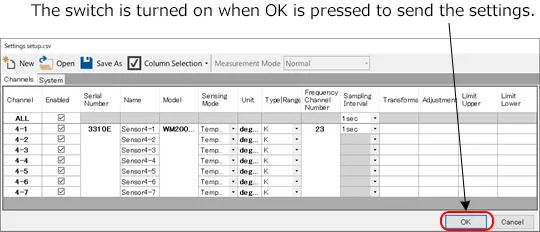Battery Know-how
Operating Temperature and Battery Capacity
The usable capacity of a battery depends on the temperature at the time of use.
Battery capacity is determined by multiplying current and time (i.e., the integral value of current).
If a battery runs out of power after being used at a low temperature such as 0℃, it implies that the battery has used its capacity to operate at a low temperature.
A battery that runs out of power at a low temperature can be used at 25℃ because the usable battery capacity increases when the temperature rises to 25℃.
On the other hand, if a battery is used for an extended period of time at 25℃ and the battery capacity exceeds the capacity that can be used at low temperature, the battery will be out of power when the temperature is lowered.
Check for remaining battery capacity in the standard software of AirLogger™ is based on battery voltage.
At low temperatures, the remaining battery capacity is not displayed correctly since the battery voltage drops.
In particular, the voltage drops rapidly regardless of the remaining battery capacity when the operating temperature is lowered below 0℃.
Please make sure to check for the remaining battery capacity based on the results at 25℃ and judge accordingly.

Sampling Period and Power Consumption
Battery-operated wireless devices operate in a time-division mode since reduction of power consumption becomes a key.
In AirLogger™, the wireless function consumes the most power. Hence, the fewer the number of transmissions, the lower the power consumption.
In WM2000, the operation switches between 100 ms, 1 s, and 10 s sampling, resulting in a significant change in power consumption.
When sampling is less than 1 s, several transmissions are made in 1 s, and from 1 s and above, the interval between transmissions becomes every 2 s. When sampling is 10 s and above, it operates only for the first 2 s and enters into sleep state for the rest of the time.
When sampling is less than 100 ms, AirLogger™ performs high-speed wireless transmission, so power consumption becomes very large.
AirLogger™ Switches
AirLogger™ has different switches depending on the type of unit.
- The WM1000 has a switch on the side of the measurement unit.
- The WM2000 series have a software switch.
How to Turn on the Switches
For the WM1000, turn on the side switches one by one.
WM2000 switches on when the setting is sent to the setting screen and succeeds.


Power Consumption
The WM1000 does not draw current when switched off. If the measurement unit is turned on and the software is not running, the measurement unit consumes significant power when it switches on to look for the PC communication unit for pairing.
If the software is closed, the switch should be turned off.
Since the WM2000 has a software switch, it has a small standby current that gradually consumes a small amount of power.
It is recommended to remove the batteries if the WM2000 will not be in use for a long period of time.
How to Turn Off the Switches
The switch of WM1000 must be turned off one by one. The risk of forgetting to turn off the switches can be reduced by turning them off while watching the communication status in the standard software.
For WM2000, close the standard software or uncheck the “Enabled” checkbox on the measurement unit and send the settings to turn off the switch.


Notes on Using Portable Battery Chargers (Contact us for details)
Power can be supplied from a commercially available portable battery charger (power bank) by using an external power supply cable.
Please use an IoT-compatible portable battery charger as the power supply. *
Recommended products: BL1040B (Makita) CHE-104 (TRA) CHE-061 (TRA) 7838 (Kaito Denshi)
* For safety reasons, portable battery chargers for smartphones and other devices have a function to stop supplying power if a small current is supplied for a long period of time.
Since AirLogger™ consumes small power, this function is actuated and the power supply is stopped. It has been confirmed that the above recommended products do not stop power supply.
Battery Replacement During Measurement
(WM2000 Series Long-term Monitoring Mode)
*Long-term monitoring mode is a function available with Standard Software Rev. 2.02.00, PC Communication Unit Rev. 2.2.1, and Measurement Unit Rev. 2.2.1 or higher.
For more information, please refer to “Usage Handbook: Confirmation of Revision for Software and Unit”.

In normal mode, if running out battery causes the stop of a measurement, the measurement unit is reset and the setting must be resent; thus, the measurement must be stopped.
In long-term monitoring mode, the measurement unit that has started measurement will resume measurement as is after the battery is replaced, even if running out battery causes the stop of a measurement.
Caution
The measurement unit that could not send the settings before starting measurement or could not receive the signal to start measurement will not start measurement even if the battery is replaced.
LOST data saved in the internal memory before the battery runs out can still be used even after the battery is replaced.
After the battery runs out and the measurement unit stops, measurement is stopped until the battery is replaced and the setting is sent automatically.
The data during this period will not be recovered.











